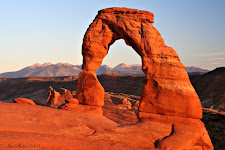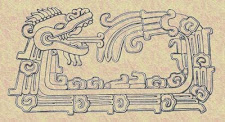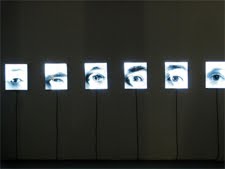Book Excerpt: from Edward Abbey, Manhattan Twilight, Hoboken Night
Eward Abbey could be called a naturalist, but I don't think that's a rough enough sounding description for him. I don't think he ever pressed a flower into his journal. I doubt he ever collected rocks. He was content to explore the earth and leave it as he found it. And if he found it paved he was content to throw a beer can out his car window because, as he'd say, it's already ruined.
He fantasized about blowing up the Glen Canyon Dam, the massive piece of industrial violence that caused the flooding of the Colorado river, forming what is now known as Lake Powell - a misnomer if there ever was one because Mr. Powell loved that river and would surely have been as appalled by the dam as Mr. Abbey. Abbey was one of the last people to raft the now flooded section of river, tread its sandbars and wooded side canyons before they were drowned, entombed in the gathering silt. He wrote about it in Desert Solitaire and he vented his ecoterrorist impulses in the hilarious novel The Monkey Wrench Gang.
He lived most of his life in Moab, Utah and became identified with desert southwest, but like many western Americans he had eastern roots and lived for a while in New York City. He was as keen an observer of urbanity as he was of nature and though he ultimately reviled the city's toxic vitality, he also found beauty in it. In the rust and oil. In the crumbling bricks. In the sprigs of dirty spring growth pushing up through the pavement. The story this excerpt is taken from is a rare glimpse of his time in the city and it is so keen and lyrical, so Kerouacian in its lithe and rhythmic execution that it makes one wish Mr Abbey had turned his lens more often on the world of men.
For two years I lived in Hoboken, far from my natural habitat. The bitter bread of exile. Two years in the gray light of the sulfur dioxide and the smell of burning coffee beans from the Maxwell House plant at the end of Hudson Street. In a dark, dank, decaying apartment house where the cockroaches - shell-backed, glossy, insolent Blatella germanica - festered and spawned under the linoleum on the sagging floors, behind the rippled wallpaper on the sweating walls, among the teacups in the cupboard. Everywhere. While the rats raced in ferocious packs, like wolves, inside the walls and up and down the cobblestone alleyways that always glistened, night and day, in any kind of weather, with a thin chill greasy patina of poisonous dew. The fly ash everywhere, falling softly and perpetually from the pregnant sky. We watched the seasons come and go in a small rectangle of walled-in space we called our yard: in spring and summer the black grass; in fall and winter the black snow. Overhead and in our hearts a black sun.
Down in the cellar and up in the attic of that fantastic house - four stories high, brownstone, a stoop, wide, polished banisters, brass fittings on the street entrance, a half-sunken apartment for the superintendent, high ceilings, high windows and a grand stairway on the main floor, all quite decently middle class and in the better part of town, near the parks, near the Stevens Institute of Technology - hung draperies of dust and cobweb that had not been seen in the light of day or touched by the hand of man since the time of the assassination of President William McKinley.
In the sunless attic the spiders had long since given up, for all their prey had turned to dust; but the rats roamed freely. Down in the basement, built like a dungeon with ceiling too low to permit a man of normal stature to stand erect, there were more rats, of course - they loved the heat of the furnace in winter - and dampish stains on the wall and floor where the great waterbugs, like cockroaches out of Kafka, crawled sluggishly from darkness into darkness. One might notice here, at times, the odor of sewer gas.
The infinite richness. The ecology, the natural history of it all. An excellent workshop for the philosopher, for who would venture out into that gray miasma of perpetual smoke and fog that filled the streets if he might remain walled up with books, sipping black coffee, smoking black Russian cigarettes, thinking long, black, inky thoughts? To be sure. but there were the streets. The call of the streets.
We lived one block from the waterfront. The same waterfront where Marlon Brando once played Marlon Brando, where the rust-covered tramp steamers, black freighters, derelict Dutchmen, death ships came to call under Liberian flags to unload their bananas, baled hemp, teakwood, sacks of coffee beans, cowhides, Argentine beef, to take on kegs of nails, jeep trucks, Cadillacs and crated machine guns. Abandoned by the Holland-American Line in '65, at least for passenger service, the Hoboken docks - like Hoboken bars and Hoboken tenements - were sinking into an ever deepening state of decay. The longshoremen were lucky to get two days' work a week. Some of the Great warehouses had been empty for years; the kids played Mafia in them.
The moment I stepped out the front door I was faced again with Manhattan. There it was, oh splendid ship of concrete and steel, aluminum, glass and electricity, forging forever up the dark river. (The Hudson - like a river of oil, filthy and rich, gleaming with silver lights.) Manhattan at twilight: floating gardens of tender neon, the lavender towers where each window glittered at sundown with reflected incandescence, where each crosstown street became at evening a gash of golden fire, and the endless flow of the endless traffic on the West Side Highway resembled a luminous necklace strung round the island's shoulders.
travel, philosophy, art, culture
Blog Archive
Music
Video: Derek Paravicini - Musical Genius
Video: M Ward - Chinese TranslationMusic
Video: Jennifer Grout - sings Umm Kulthum on "Arabs Got Talent"
Photos
Baja Surf Trip
Topanga Canyon, Fall 2010
Devils Tower Sequence
Spring/Summer 2010 Travel Pics
More Travel Pics
My Summer Home in Oregon
Clark Little Surf Photography
Videos
Music: M Ward - Chinese Translation
Interview: linguist David Harrison
Music: Derek Paravicini - Musical Genius
Video: Derek Paravicini - Musical Genius
Video: M Ward - Chinese TranslationMusic
Video: Jennifer Grout - sings Umm Kulthum on "Arabs Got Talent"
Photos
Baja Surf Trip
Topanga Canyon, Fall 2010
Devils Tower Sequence
Spring/Summer 2010 Travel Pics
More Travel Pics
My Summer Home in Oregon
Clark Little Surf Photography
Videos
Music: M Ward - Chinese Translation
Interview: linguist David Harrison
Music: Derek Paravicini - Musical Genius
Video: One in 8 Million: photo essays of individual New Yorker's lives (from The New York Times)
Music: Jennifer Grout - Sings Umm Kulthum on "Arabs Got Talent"
Poetry
Music: Jennifer Grout - Sings Umm Kulthum on "Arabs Got Talent"
Poetry
Denice Cacace - Haiku
John Keats - Bright Star
John Updike - A Rescue
Billy Collins - Thesaurus
John Dunn - Handwritten Letter
John Dunn - Gettin' All Poetiky
Johann Wolfgang Von Goethe - The Erl-King
Books
Edward Abbey - Manhattan Twilight, Hoboken Night (from The Journey Home)
Don Delillo - Underworld
Jorge Luis Borges - The Secret Miracle (From Labyrinths)
Robert Penn Warren - All The King's Men
John Keats - Bright Star
John Updike - A Rescue
Billy Collins - Thesaurus
John Dunn - Handwritten Letter
John Dunn - Gettin' All Poetiky
Johann Wolfgang Von Goethe - The Erl-King
Books
Edward Abbey - Manhattan Twilight, Hoboken Night (from The Journey Home)
Don Delillo - Underworld
Jorge Luis Borges - The Secret Miracle (From Labyrinths)
Robert Penn Warren - All The King's Men
Essays
Multiple authors: Fifteen Unforgettable Movie Moments (from Salon)
John Dunn: LA Love Letter
John Dunn: Impressions of the Badlands, Black Hills and Little Bighorn
Matt Power: Mississippi Drift - River Vagrants in the Age of Wal-Mart (from Harper's)
Kevin Fedarko: High in Hell - An Epic Drug Fueled Travel Story (from Esquire)
John Dunn: Getting Myspaced - Self Discovery Through Social Networking
John Bradley: Golf Bro Will Mackenzie - Making it Cool to Watch Golf Again (from Outside)
John Dunn: Golf Course Review: Old Macdonald - Doak's Encore at Bandon
John Dunn: LA Love Letter
John Dunn: Impressions of the Badlands, Black Hills and Little Bighorn
Matt Power: Mississippi Drift - River Vagrants in the Age of Wal-Mart (from Harper's)
Kevin Fedarko: High in Hell - An Epic Drug Fueled Travel Story (from Esquire)
John Dunn: Getting Myspaced - Self Discovery Through Social Networking
John Bradley: Golf Bro Will Mackenzie - Making it Cool to Watch Golf Again (from Outside)
John Dunn: Golf Course Review: Old Macdonald - Doak's Encore at Bandon

"A weird, lovely, fantastic object out of nature like Delicate Arch has the curious ability to remind us - like rock and sunlight and wind and wildflowers - that out there is a different world, older and greater and deeper by far than ours, a world which sustains the little world of man as sea and sky surround and sustain a ship. For a little while we are again able to see, as the child sees, a world of marvels. For a few moments we discover that nothing can be taken for granted, for if this ring of stone is marvelous, then all which shaped it is marvelous, and our journey here on Earth, able to see and touch and hear in the midst of tangible and mysterious things-in-themselves, is the most strange and daring of all adventures." - Edward Abbey, Desert Solitaire

"It is impossible to convey the life-sensation of any given epoch of one's existence - that which makes its truth, its meaning, its subtle penetrating essence. It is impossible. We live, as we dream, alone." - Joseph Conrad, Heart of Darkness

"Full circle from the tomb of the womb to the womb of the tomb we come, an ambiguous, enigmatical incursion into a world of solid matter that is soon to melt from us like the substance of a dream." - Joseph Campbell, Hero with a 1000 Faces

"The cactus of the high desert is a small grubby, obscure and humble vegetable associated with cattle dung and overgrazing, interesting only when you tangle with it the wrong way. Yet from this nest of thorns, this snare of hooks and fiery spines, is born once each year a splendid flower. It is unpluckable and except to an insect almost unapproachable, yet soft, lovely, sweet, desirable, exemplifying better than the rose among thorns the unity of opposites" - Edward Abbey, Desert Solitaire

"He knew that the very memory of the piano falsified still further the perspective in which he saw the elements of music, that the field open to the musician is not a miserable stave of seven notes, but an immeasurable keyboard on which, here and there only, separated by the thick darkness of its unexplored tracts, some few of the millions of keys of tenderness, of passion, of courage, of serenity, which compose it, each one differing from all the rest as one universe differs from another, have been discovered by a few great artists who do us all a service, when they awaken in us the emotion corresponding to the theme they have discovered, of showing us what richness, what variety lies hidden, unknown to us, in that vast, unfathomed and forbidden night of our soul." - Marcel Proust, Swann's Way

"Perhaps it is not-being that is the true state, and all our dreams of life are inexistent. We shall perish, but we have as hostages these phrases of music, these divine captives who will follow and share our fate. And death in their company is somehow less bitter, less inglorious, perhaps even less probable." - Marcel Proust, Swann's Way

"The creature was very young. He was alone in a dread universe. I crept on my knees and crouched beside him. It was a small fox pup from a den under the timbers who looked up at me. God knows what had become of his brothers and sisters. His parents must not have been home from hunting. He innocently selected what I think was a chicken bone from an untidy pile of splintered rubbish and shook it at me invitingly... the universe was swinging in some fantastic fashion around to present its face and the face was so small that the universe itself was laughing.
It was not a time for human dignity. It was a time only for the careful observance of amenities written behind the stars. Gravely I arranged my forepaws while the puppy whimpered with ill-concealed excitement. I drew the breath of a fox's den into my nostrils. On impulse, I picked up clumsily a whiter bone and shook it in teeth that had not entirely forgotten their original purpose. Round and round we tumbled and for just one ecstatic moment I held the universe at bay by the simple expedient of sitting on my haunches before a fox den and tumbling about with a chicken bone. It is the gravest, most meaningful act I shall ever accomplish, but, as Thoreau once remarked of some peculiar errand of his own, there is no use reporting it to the Royal Society." - Loren Eiseley, The Star Thrower
It was not a time for human dignity. It was a time only for the careful observance of amenities written behind the stars. Gravely I arranged my forepaws while the puppy whimpered with ill-concealed excitement. I drew the breath of a fox's den into my nostrils. On impulse, I picked up clumsily a whiter bone and shook it in teeth that had not entirely forgotten their original purpose. Round and round we tumbled and for just one ecstatic moment I held the universe at bay by the simple expedient of sitting on my haunches before a fox den and tumbling about with a chicken bone. It is the gravest, most meaningful act I shall ever accomplish, but, as Thoreau once remarked of some peculiar errand of his own, there is no use reporting it to the Royal Society." - Loren Eiseley, The Star Thrower

The moment I stepped out the front door I was faced again with Manhattan. There it was, oh splendid ship of concrete and steel, aluminum, glass and electricity, forging forever up the dark river. (The hudson - like a river of oil, filthy and rich, gleaming with silver lights.) Manhattan at twilight: floating gardens of tender neon, the lavender towers where each window glittered at sundown with reflected incandescence, where each crosstown street became at evening a gash of golden fire, and the endless flow of the endless traffic on the West Side Highway resembled a luminous necklace strung round the island's shoulders. - Edward Abbey, Manhattan Twilight, Hoboken Night

Sometimes I see something so moving I know I'm not supposed to linger. See it and leave. If you stay too long, you wear out the wordless shock. Love it and trust it and leave. - Don Delillo, Underworld

Yes. Because they were human men. They were trying to write down the heart's truth out of the heart's driving complexity, for all the complex and troubled hearts which would beat after them. - William Faulkner, The Bear

He picks up speed and seems to lose his gangliness, the slouchy funk of hormones and unbelonging and all the stammering things that seal his adolescence. He is just a running boy, a half-seen figure from the streets, but the way running reveals some clue to being, the way a runner bares himself to consciousness, this is how the dark-skinned kid seems to open to the world, how the bloodrush of a dozen strides bring him into eloquence. - Don Delillo, Underworld

If somewhere beneath the blood, the past must beat in me to make a rhythm of survival for itself - to go on as this half-life which echoes as a second pulse inside the ticking moments of my existence - if this is what must be, why is the pattern of remembered instants so uneven, so gapped and rutted and plunging and soaring? I can only believe it is because memory takes its pattern from the earliest moments of the mind, from childhood. And childhood is a most queer flame-lit and shadow-chilled time. - Ivan Doig, This House of Sky

The storm front towered above them and the wind was cool on their sweating faces. They slumped bleary-eyed in their saddles and looked at one another. Shrouded in the black thunderheads the distant lightning glowed mutely like welding seen through foundry smoke. As if repairs were under way at some flawed place in the iron dark of the world. - Cormac McCarthy, All the Pretty Horses
.jpg)
Men believe the cure for war is war as the curandero prescribes the serpent's flesh for its bite. - Cormac McCarthy, All the Pretty Horses

Big production, no story, as they say around the movie lots. I guess Sylvia is happy enough, though not necessarily with me. In our circle that's not too important. There's always something to do if you don't have to work or consider the cost. It's no real fun, but the rich don't know that. They never had any. They never want anything very hard except maybe somebody else's wife and that's a pretty pale desire compared to the way a plumber's wife wants new curtains for the living room. - Raymond Chandler, The Long Goodbye
The charged atmosphere made every little thing stand out as a performance, a movement distinct and vastly important. It was one of those hypersensitive moments when all your automatic movements, however long established, however habitual, become separate acts of will. You are like a man learning to walk after polio. You take nothing for granted, absolutely nothing at all. - Raymond Chandler, The Long Goodbye
We live entirely, especially if we are writers, by the imposition of a narrative line upon disparate images, by the "ideas" with which we have learned to freeze the shifting phantasmagoria which is our actual experience. - Joan Didion, The White Album

Seattle rain smells different from New Orleans rain... New Orleans rain smells of sulfur and hibiscus, trumpet metal, thunder and sweat. Seattle rain, the widespread rain of the Great Northwest, smells of green ice and sumi ink, of geology and silence and minnow breath. - Tom Robbins, Jitterbug Perfume

"There was a special pallor in the face of the New York emigres. Lasher and Grappa in particular. They had the wanness of obsession, of powerful appetites confined to small spaces. Murray said that Eliot Nasher had film noir face. His features were sharply defined, his hair perfumed with some oily extract. I had the curious thought that these men were nostalgic for black-and-white, their longings dominated by achromatic values, personal extremes of postwar urban gray." - Don Delillo, White Noise








No comments:
Post a Comment